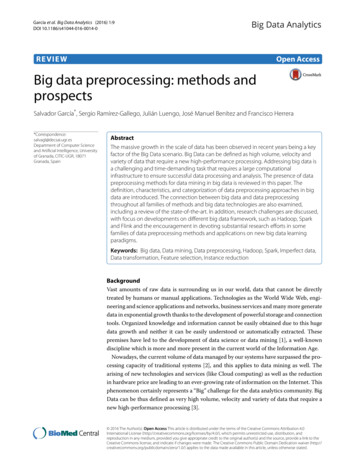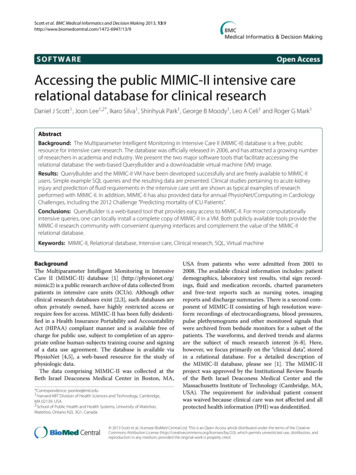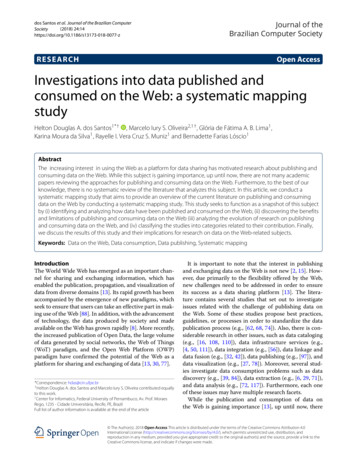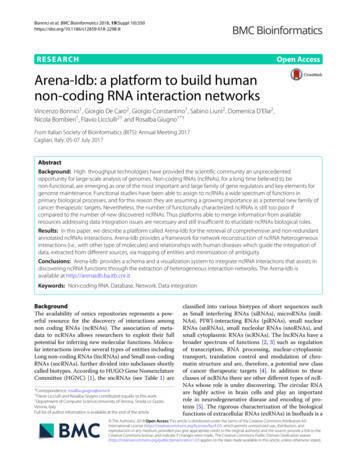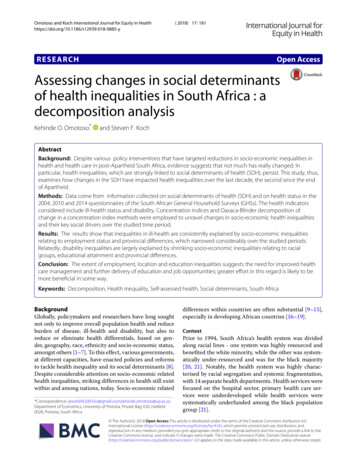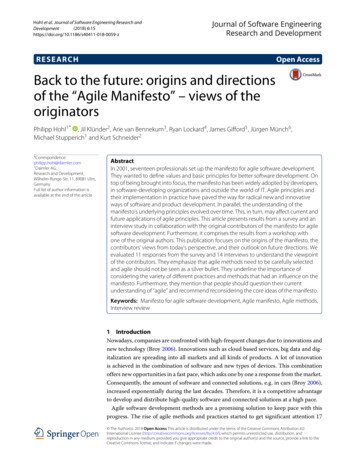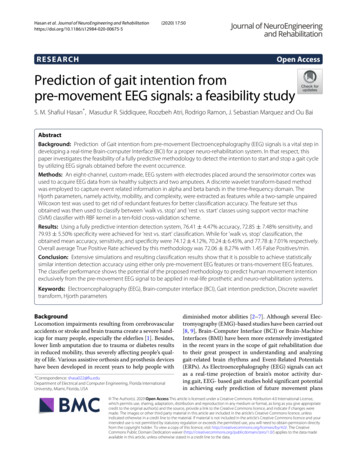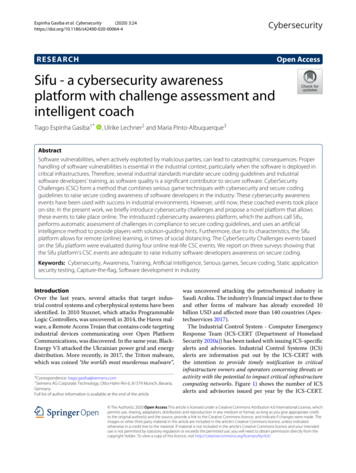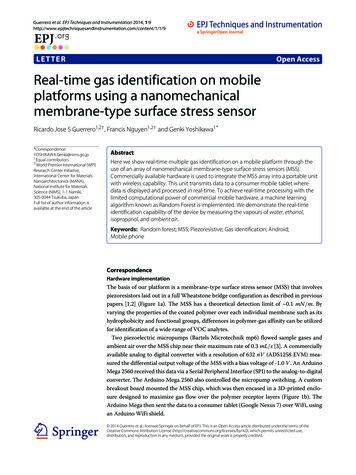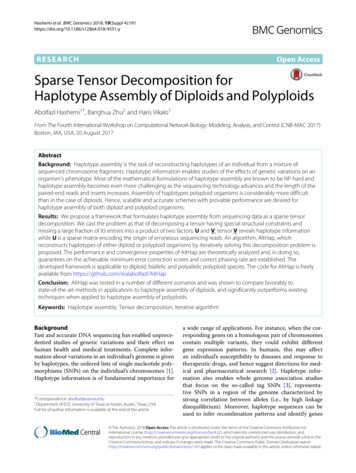
Transcription
Hashemi et al. BMC Genomics 2018, 19(Suppl 4):191https://doi.org/10.1186/s12864-018-4551-yR ES EA R CHOpen AccessSparse Tensor Decomposition forHaplotype Assembly of Diploids and PolyploidsAbolfazl Hashemi1* , Banghua Zhu2 and Haris Vikalo1From The Fourth International Workshop on Computational Network Biology: Modeling, Analysis, and Control (CNB-MAC 2017)Boston, MA, USA. 20 August 2017AbstractBackground: Haplotype assembly is the task of reconstructing haplotypes of an individual from a mixture ofsequenced chromosome fragments. Haplotype information enables studies of the effects of genetic variations on anorganism’s phenotype. Most of the mathematical formulations of haplotype assembly are known to be NP-hard andhaplotype assembly becomes even more challenging as the sequencing technology advances and the length of thepaired-end reads and inserts increases. Assembly of haplotypes polyploid organisms is considerably more difficultthan in the case of diploids. Hence, scalable and accurate schemes with provable performance are desired forhaplotype assembly of both diploid and polyploid organisms.Results: We propose a framework that formulates haplotype assembly from sequencing data as a sparse tensordecomposition. We cast the problem as that of decomposing a tensor having special structural constraints andmissing a large fraction of its entries into a product of two factors, U and V; tensor V reveals haplotype informationwhile U is a sparse matrix encoding the origin of erroneous sequencing reads. An algorithm, AltHap, whichreconstructs haplotypes of either diploid or polyploid organisms by iteratively solving this decomposition problem isproposed. The performance and convergence properties of AltHap are theoretically analyzed and, in doing so,guarantees on the achievable minimum error correction scores and correct phasing rate are established. Thedeveloped framework is applicable to diploid, biallelic and polyallelic polyploid species. The code for AltHap is freelyavailable from https://github.com/realabolfazl/AltHap.Conclusion: AltHap was tested in a number of different scenarios and was shown to compare favorably tostate-of-the-art methods in applications to haplotype assembly of diploids, and significantly outperforms existingtechniques when applied to haplotype assembly of polyploids.Keywords: Haplotype assembly, Tensor decomposition, Iterative algorithmBackgroundFast and accurate DNA sequencing has enabled unprecedented studies of genetic variations and their effect onhuman health and medical treatments. Complete information about variations in an individual’s genome is givenby haplotypes, the ordered lists of single nucleotide polymorphisms (SNPs) on the individual’s chromosomes [1].Haplotype information is of fundamental importance for*Correspondence: abolfazl@utexas.eduDepartment of ECE, University of Texas at Austin, Austin, Texas, USAFull list of author information is available at the end of the article1a wide range of applications. For instance, when the corresponding genes on a homologous pair of chromosomescontain multiple variants, they could exhibit differentgene expression patterns. In humans, this may affectan individual’s susceptibility to diseases and response totherapeutic drugs, and hence suggest directions for medical and pharmaceutical research [2]. Haplotype information also enables whole genome association studiesthat focus on the so-called tag SNPs [3], representative SNPs in a region of the genome characterized bystrong correlation between alleles (i.e., by high linkagedisequilibrium). Moreover, haplotype sequences can beused to infer recombination patterns and identify genes The Author(s). 2018 Open Access This article is distributed under the terms of the Creative Commons Attribution 4.0International License (http://creativecommons.org/licenses/by/4.0/), which permits unrestricted use, distribution, andreproduction in any medium, provided you give appropriate credit to the original author(s) and the source, provide a link to theCreative Commons license, and indicate if changes were made. The Creative Commons Public Domain Dedication o/1.0/) applies to the data made available in this article, unless otherwise stated.
Hashemi et al. BMC Genomics 2018, 19(Suppl 4):191under positive selection [4]. In addition to the SNPs andminor structural variations found in a healthy individual’s genome, complex chromosomal aberrations such astranslocations and nonreciprocal structural changes –including aneuploidy – are present in cancer cells. Cancer haplotype assembly enables identification of “driver”mutations and thus helps to understanding the mechanisms behind the disease and discovery of its geneticsignatures.Haplotype assembly from short reads obtained byhigh-through-put DNA sequencing requires partitioning(either directly or indirectly) the reads into K clusters(K 2 for diploids, K 3 for triploids, etc.), eachcollecting the reads corresponding to one of the chromosomes. If the reads were free of sequencing errors,this task would be straightforward. However, sequencing is erroneous – state-of-the-art platforms have errorrates on the order of 10 3 10 2 . This leads to ambiguities regarding the origin of a read and therefore rendershaplotype assembly challenging. For this reason, the vastmajority of haplotype assembly techniques attempts toremove the aforementioned ambiguities by either discarding or altering sequencing data; this has led to theminimum fragment removal, minimum SNP removal [5],maximum fragments cut [6], and minimum error correction formulations of the assembly problem [7]. Mostof the recent haplotype assembly methods (see, e.g., [8–12]) focus on the minimum error correction (MEC) formulation where the goal is to find the smallest numberof nucleotides in reads that need to be changed so thatany read partitioning ambiguities would be resolved. Ithas been shown that finding optimal solution to the MECformulation of the haplotype assembly problem is NPhard [5, 12, 13]. In [14], the authors used a branch-andbound scheme to minimize the MEC objective over thespace of reads; to reduce the search space, they reliedon a bound on the objective obtained by a random partition of the reads. Unfortunately, exponential growth ofthe complexity of this scheme makes it computationallyinfeasible even for moderate haplotype lengths. Integerlinear programming techniques have been applied to haplotype assembly in [15], but the approach there fails atcomputationally difficult instances of the problem. Morerecently, fixed parameter tractable (FPT) algorithms withruntimes exponential in the number of variants per read[16, 17] were proposed; these methods are well-suitedfor short reads but become infeasible for the long ones.A dynamic programming scheme for haplotype assembly of diploids proposed in [18] is also exponential inthe length of the longest read. A probabilistic dynamicprogramming algorithm that optimizes a likelihood function generalizing the MEC objective is developed in [10];this method is characterized by high accuracy but is significantly slower than the previous heuristics. AuthorsPage 2 of 25in [9, 11] aim to process long reads by developing algorithms for the exact optimization of weighted variantsof the MEC score that scale well with read length butare exponential in the sequencing coverage. These methods, along with ProbHap [10], struggle to remain accurateand practically feasible at high coverages (e.g., higherthan 12 [10]).The computational challenges of optimizing MEC scorehas motivated several polynomial time heuristics. In apioneering work [19], a greedy algorithm seeking themost likely haplotypes was used to assemble haplotypesof the first complete diploid individual genome obtainedvia high-throughput sequencing. To compute posteriorjoint probabilities of consecutive SNPs, Bayesian methodsrelying on MCMC and Gibbs sampling schemes were proposed in [20] and [21], respectively; unfortunately, slowconvergence of Markov chains that these schemes rely onlimits their practical feasibility. Following an observationthat haplotype assembly can be interpreted as a clusteringproblem, a max-cut formulation was proposed in [22]; anefficient algorithm (HapCUT, recently upgraded to HapCUT2 [23]) that solves it and significantly outperformsthe method in [19] was developed and has widely beenused. A flow-graph based approach in [24], HapCompass, re-examined fragment removal strategy and demonstrated superior performance over HapCUT. Other recentdiploid haplotype assembly methods include a greedymax-cut approach in [25], convex optimization programfor minimizing the MEC score in [26], a communicationtheoretic interpretation of the problem solved via beliefpropagation (BP) in [27], and methods that use externalreference panels such as 1000 Genomes to improve accuracy of haplotype assembly in [28, 29]. Note that deepsequencing coverage provided by state-of-the-art highthroughput sequencing platforms and the emergence ofvery long insert sizes in recent technologies (e.g., fosmid[25]) may enable assembly of extremely long haplotypeblocks but also impose significant computational burdenon the methods above.Increased affordability, capability to provide deep coverage, and longer sequencing read lengths also enabledstudies of genetic variations of polyploid organisms. However, haplotype assembly for polyploid genomes is considerably more challenging than that for diploids; to illustratethis, note that for a polyploid genome with k haplotype sequences of length m, under the all-heterozygousassumption there are (k 1)m different genotypes andat least 2(m 1) (k 1)m different haplotype phasings. Inpart for this reason relatively fewer methods for solvingthe haplotype assembly problems in polyploids have beendeveloped. In fact, with the exception of HapCompass[24], SDhaP [26] and BP [27], the above listed methods are restricted to diploid genomes. Other techniquescapable of reconstructing haplotypes for both diploid
Hashemi et al. BMC Genomics 2018, 19(Suppl 4):191and polyploid genomes include HapTree [30], a Bayesianmethod to find the maximum likelihood haplotype shownto be superior to HapCompass and SDhaP (see, e.g.,[31] for a detailed comparison), H-PoP [8], the state-ofthe-art dynamic programming method that significantlyoutperforms the schemes developed in [24, 26, 30] interms of accuracy, memory consumption, and speed,and the recently proposed matrix factorization schemesin [32, 33].In this paper, we propose a unified framework for haplotype assembly of diploid and polyploid genomes based onsparse tensor decomposition; the framework essentiallysolves a relaxed version of the NP-hard MEC formulation of the haplotype assembly problem. In particular,read fragments are organized in a sparse binary tensorwhich can be thought of as being obtained by multiplying a matrix that contains information about the originof erroneous sequencing reads and a tensor that containshaplotype information of an organism. The problem thenis recast as that of decomposing a tensor having specialstructural constraints and missing a large fraction of itsentries. Based on a modified gradient descent methodand after unfolding the observed and haplotype information bearing tensors, an iterative procedure for findingthe decomposition is proposed. The algorithm exploitsunderlying structural properties of the factors to performdecomposition at a low computational cost. In addition,we analyze the performance and convergence properties of the proposed algorithm and determine bounds onthe minimum error correction (MEC) scores and correctphasing rate (CPR) – also referred to as reconstructionrate – that the algorithm achieves for a given sequencing coverage and data error rate. To the best of ourknowledge, this is the first polynomial time approximation algorithm for haplotype assembly of diploids andpolyploids having explicit theoretical guarantees for itsachievable MEC score and CPR. The proposed algorithm,referred to as AltHap, is tested in applications to haplotype assembly for both diploid and polyploid genomes(synthetic and real data) and compared with several stateof-the-art methods. Our extensive experiments reveal thatAltHap outperforms the competing techniques in termsof accuracy, running time, or both. It should be noted thatwhile state-of-the-art haplotype assembly methods forpolyploids assume haplotypes may only have biallelic sites,AltHap is capable of reconstructing polyallelic haplotypeswhich are common in many plants and some animals,are of particular importance for applications such as cropcultivation [34], and may help in reconstruction of viralquasispecies [35]. Moreover, while many state-of-the-arthaplotype assembly methods are computationally intensive (e.g., [10, 15]), our extensive numerical experimentsdemonstrate efficacy of AltHap in a variety of practicalsettings.Page 3 of 25MethodsProblem formulationWe briefly summarize notation used in the paper. Boldcapital letters refer to matrices and bold lowercase letters represent vectors. Tensors are denoted by underlinedbold capital letters, e.g., M. M::1 and M denote the frontalslice and the mode-1 unfolding of a third-order tensorM, respectively. For a positive integer n, [ n] denotes theset {1 . . . , n}. The condition number of rank-k matrix Mis defined as κ σ1 /σk where σ1 · · · σk 0are singular values of M. SVDk (M) denotes the rank kapproximation (compact SVD) of M computed by poweriteration method [36, 37].Let H {h1 , . . . , hk } denote the set of haplotypesequences of a k-ploid organism, and let R be an n m SNPfragment matrix where n denotes the number of sequencing reads and m is the length of haplotype sequences. Ris an incomplete matrix that can be thought of as beingobtained by sampling, with errors, matrix M that consists of n rows; each row of M is a sequence randomlyselected from among k haplotype sequences. Since eachSNP is one of four possible nucleotides, we use the alphabet A {(1, 0, 0, 0), (0, 1, 0, 0), (0, 0, 1, 0), (0, 0, 0, 1)} todescribe the information in the haplotype sequences; themapping between nucleotides and alphabet componentsfollows arbitrary convention. The reads can now be organized into an n m 4 SNP fragment tensor which wedenote by R. The (i, j, :) fiber of R, i.e., a one-dimensionalslice obtained by fixing the first and second indices of thetensor, represents the value of the jth SNP in the ith read.Let denote the set of informative fibers of R, i.e., the setof (i, j, :) such that the ith read covers the jth SNP. Definean operator P (.) as P (R) ij: Rij: (i, j, :) 0, otherwise.(1)P (R) is a tensor obtained by sampling, with errors,tensor M An m having n copies of k encoded haplotype sequences as its horizontal slices. More specifically,we can write M UV , where V Am k contains haplotype information, i.e., the jth vertical slice of V, V:j: , is theencoded sequence of the jth haplotype, and U {0, 1}n kis a matrix that assigns each of n horizontal slices of M toone of k haplotype sequences, i.e., the ith row of U, ui , is anindicator of the origin of the ith read. Let {e1 , . . . , ek },where el Rk is the lth standard basis vector having 1in the lth position and 0 elsewhere. The rows of U arestandard unit basis vectors in Rk , i.e., ui , i [ n].This representation is illustrated in Fig. 1 where the (1, 1, :)fiber of V specified with dashed lines is mapped to the(1, 1, :) fiber of M which in turn implies that in the exampledescribed in Fig. 1 we have u1 e1 .
Hashemi et al. BMC Genomics 2018, 19(Suppl 4):191Page 4 of 25Fig. 1 Representing haplotype sequences and sequencing reads using tensors. Tensor V Am k contains haplotype information while matrixU {0, 1}n k assigns each of the n horizontal slices of M to one of the k haplotype sequences, i.e., the ith row of U is an indicator of the origin of theith readDNA sequencing is erroneous and hence we assume amodel where the informative fibers in R are perturbed versions of the corresponding fibers in M with data error ratepe , i.e., if the (i, j, :) fiber in M takes value el A,Rij: with probability 1 pe equals el and with probability pe takes one of the other three possibilities. Thus, theobserved SNP fragment tensor can be modeled as R P (M N) where N is an additive noise tensor defined as 0,w.p 1 pe(2)Nij: U (A\{Mij: }) Mij: , w.p pe ,where the notation U (A\{Mij: }) denotes uniform selection of a vector from A\{Mij: }. The goal of haplotypeassembly can now be formulated as follows: Given the SNPfragment tensor R, find the tensor of haplotype sequencesV that minimizes the MEC score.Next, we formalize the MEC score as well as the correct phasing rate, also known as reconstruction rate, thetwo metrics that are used to characterize performance ofhaplotype assembly schemes (see, e.g., [15, 18, 38, 39]).For two alleles a1 , a2 A {0}, we define a dissimilarityfunction d(a1 , a2 ) as 1, if a1 , a2 0 and a1 a2(3)d(a1 , a2 ) 0,otherwise.The MEC score is the smallest number of fibers in R thatneed to be altered so that the resulting modified data isconsistent with the reconstructed haplotype V, i.e.,MEC n i 1minp 1,.,km d(Rij: , Vjp: ).(4)where M is a one-to-one mapping from lateral slices of Vto those of Vt , i.e., a one-to-one mapping from the set ofreconstructed haplotypes to the set of true haplotypes.We now describe our proposed relaxation of the MECformulation of the haplotype assembly problem. Let pi [ k], i [ n] be defined as pi arg minp md Rij: , Vjp: .j 1 Notice that for any j such that d Rij: , Vjp: 1, Rij: Vjp: 22 2. Therefore, by denoting ni 1 i where ithe set of informative fibers for the ith read we obtainpi arg minpm d Rij: , Vjp: j 1 1arg min Rij: P i Vjp: 22p2m j 1(6) 1arg min Ri:: P i V:p: 2Fp2 (b) 1 arg min vec(Ri:: ) vec P i V:p: 22p2(a) where (a) follows from the definition of the Frobeniusnorm and vec(.) in (b) denotes the vectorization of itsargument. Let ep be the pth standard unit vector p [ k].It is straightforward to observe that the last equality in (6)can equivalently be written aspi 1arg min vec(Ri:: ) P i Vep 22p2j 1The correct phasing rate (CPR), also referred to as thereconstruction rate, can conveniently be written using thedissimilarity function d(., .). Let Vt denote the tensor oftrue haplotype sequences. Then m k 1 CPR 1 mind M(V)ij: , Vtij: , (5)mk Mi 1 j 1where V is the mode-1 unfolding of the tensor V. Hence, 1 vec(Ri:: ) P i Vep 22 .2nMEC i 1Let U {0, 1}n k be the matrix such that for its ith rowit holds that ui epi . In addition, notice that vec(Ri:: )
Hashemi et al. BMC Genomics 2018, 19(Suppl 4):191is the ith row of R. Therefore, from the definition of theFrobenius norm and the fact that P (R) R we obtain 1 2 MEC min P R UV .(7)FU,V 2The optimization problem in (7) is NP-hard since theentries of V are binary and the objective function is nonconvex. Relaxing the binary constraint to Vi,j C , i [ 4m] , j [ k], where C [ 0, 1], results in the followingrelaxation of the MEC formulation, 1 2 min P R UV F2U,V(8)s.t. Vi,j C , i [ 4m] , j [ k]ui , i [ n] .The new formulation can be summarized as follows. Westart by finding the so-called mode-1 unfolding of ten sors M and V and denote the decomposition M UV ,as illustrated in Fig. 2. As implied by the figure, afterunfolding, the entries of the (1, 1, :) fiber are mapped tofour blocks of M and V that correspond to the frontalslices of tensors M and V, respectively. Then, to determine the haplotype sequence that minimizes the MECscore, one needs to solve (8) and find the optimal tensordecomposition.The AltHap algorithmAlthough the objective function in (8), i.e.,f (U, V) 1 P R UV 2F2is convex in each of the factors when the other factor isfixed, f (U, V) is generally nonconvex. To facilitate computationally efficient search for the solution of (8), we rely ona modified gradient search algorithm which exploits thespecial structures of U and V and iteratively updates theestimates (Ut , Vt ) starting from some initial point (U0 V0 ).More specifically, given the current estimates (Ut , Vt ), theupdate rules arePage 5 of 25Ut 1 arg minui 2 P R Ut Vt (i,j) F(9) Vt 1 C Vt α f (Vt ) ,(10) Ut 1 denoteswhere f Vt P R Ut 1 Vt the partial derivative of f U, V evaluated at Ut 1 , Vt ,α is a judiciously chosen step size, and C denotes theprojection operator onto C . Notice that the optimizationin (9) is done by exhaustively searching over k vectors in . Since the number of haplotypes k is relatively small,the complexity of the exhaustive search (9) is low. Theproposed scheme is formalized as Algorithm 1.Algorithm 1 Structured Tensor DecompositionInput: SNP fragment matrix R, step size α,maximum number of iterations TOutput: V, an estimate of the true haplotypetensor VtPreprocessing: Encode R to tensor R and findthe mode-1 unfolding, RInitialization: Using power method, Compute 1XDY SVDk P (R) and let U0 XD 2 ,1V0 YD 2 . Define {e1 , . . . , ek }for t 0, 1, 2, 3 . . . , T 1 do 1. Ut 1 arg minui (i,j) P R Ut Vt F 2. f Vt P R Ut 1 VtUt 1 3. Vt 1 C Vt α f Vtend forDecode VT to obtain VNote that AltHap differs from a previously proposedSCGD algorithm in [32] as follows: (i) AltHap’s novelrepresentation of haplotypes and sequencing reads usingbinary tensors provides a unified framework for haplotype assembly of diploids as well as biallelic and polyallelic polyploids. The method in [32] is not capable ofperforming haplotype assembly of polyallelic polyploidFig. 2 Representing haplotype sequences and sequencing reads using unfolded tensors. Matrix V {0, 1}4m k contains haplotype informationwhile matrix U {0, 1}n k assigns each of the n rows of M to one of the k haplotype sequences, i.e., the ith row of U is an indicator of the origin ofthe ith read
Hashemi et al. BMC Genomics 2018, 19(Suppl 4):191Page 6 of 25genomes. (ii) Unlike [32], AltHap exploits the fact thatV is composed of binary entries by imposing the constraint Vi,j C in the MEC relaxation in (8). As ourresults in Section 5 demonstrate, this leads to significant performance improvements of AltHap over SCGDin a variety of settings. (iii) Lastly, in Section 4 we provide analysis of the global convergence of AltHap andderive explicit analytical bounds on its achievable performance. Such performance guarantees do not exist for themethod in [32].constants C0 , C1 0 such that if is uniformly generatedat random and pe k 2 κ 6341412Csnp max C0 μ k κ Cseq ,(13)2C1 with probability at least 1 m13 , the solution (U , V ) foundby AltHap satisfies C1 κ 4 pe km 2 . M U V F2Csnp(14)Convergence analysis of AltHapIn this section, we analyze the convergence properties ofAltHap and provide performance guarantees in differentscenarios.In the Additional file 1 we show that, a judicious choiceof the step size α according to C f Vt 2Fα ,(11) 2UP fV t 1tFwhere C (0, 2) is a constant, guarantees that the valueof the objective function in (8) decreases as one alternatesbetween (9) and (10), which in turn implies that AltHapconverges. The key observation that leads to this resultis that f (U, V) is a convex function in each of the factormatrices and that C [ 0, 1] is a convex set; hence the projection C in (10) leads to a reduction of f Ut , Vt in eachiteration t.It is important however to determine the conditionsunder which the stationary point of AltHap coincides withthe global optima of (8). To this end, we first provide thedefinition of incoherence of matrices [40].Definition 1 A rank-k matrix M Rn m with singular value decomposition M Û V̂ is incoherent withparameter 1 μ max{n,m}if for every 1 i n,k1 j mk l 1μk,Û2il nk l 1μk.V̂2jl m(12)Let each fiber in MT be observed uniformly with probably p. Let Csnp mp denote the expected number ofSNPs covered by each read, and Cseq np denote theexpected coverage for each of the haplotype sequences.Theorem 1 built upon the results of [41–43] states thatwith an adequate number of covered SNPs, the solutionfound by AltHap reconstructs M up to an error term thatstems from the existence of errors in sequencing reads.Theorem 1 Assume M is μ-incoherent. Suppose thecondition number of M is κ. Then there exist numericalThe proof of Theorem 1 relies on a coupled perturbationanalysis to establish a certain type of local convexity of theobjective function around the global optima. Thus, under(13) there is no other stationary point around the globaloptima and hence, starting from a good initial point,AltHap converges globally. We employ the initializationprocedure suggested by [42] – summarized in the initialization step of Algorithm 1 – which is based on a low costsingular value decomposition of R using power method[36, 37] and with high probability lies in the describedconvexity region of f (U, V).Remark 1 Under the assumption of 1, the ConditionCsnp C0 3 μ4 k 14 κ 12 Cseq specifies a lower bound on theexpected number of covered SNPs, Csnp , that is required forthe exact recovery of M in the idealistic error-free scenario,i.e., for pe 0. With higher sequencing coverage, moreSNPs are covered by the reads and hence Csnp required foraccurate haplotype assembly scales with Cseq along withκ pe kmon the rightother parameters. Moreover, the term C12Csnphand side of (14) is the bound on the error of the solutiongenerated by AltHap which increases with the sequencingerror rate pe and ploidy k, and decreases with Csnp and thenumber of reads n, as expected.4Remark 2 If M is well-conditioned, i.e., M is characterized by a small incoherence parameter μ and asmall condition number κ, the recovery becomes easier;this is reflected in less strict sufficient condition (13) andimproved achievable performance (14). In fact, as we verified in our simulation studies, by using the proposedframework for haplotype assembly, the parameters μ and κassociated with M are close to 1 (the ideal case). Theorem 2provides theoretical bounds on the expected MEC scoresand CPR achieved by AltHap. (See Additional file 1 for theproof ).Theorem 2 Under the conditions of Theorem 1, withprobability at least 1 m13 it holds that E{MEC} 2pe Cseq m κ 4 C1 k .(15)
Hashemi et al. BMC Genomics 2018, 19(Suppl 4):191Page 7 of 25Table 1 Performance comparison of AltHap, H-PoP, BP, HapTree, SCGD, and ILP applied to haplotype reconstruction of the CEUNA12878 data set in the 1000 Genomes 932.32# 9877.7991.19041.3695.375265.07
Hashemi et al. BMC Genomics 2018, 19(Suppl 4):191Page 8 of 25Table 1 Performance comparison of AltHap, H-PoP, BP, HapTree, SCGD, and ILP applied to haplotype reconstruction of the CEUNA12878 data set in the 1000 Genomes Project 37104.69Sd1.038025.232.312221.800.5761250.37# best00010175220The best results in each Chromosome and in all Chromosomes are in bolface fontMoreover, if the reads sample haplotype sequences uniformly, with probability at least 1 m13 it holds thatE{CPR} 1 C1 κ 4 pe k.nCsnp(16)Remark 3 The bound established in ( 15) suggests thatthe expected MEC increases with the length of the haplotype sequences, sequencing error, number of haplotypesequences, and sequencing coverage. A higher sequencingcoverage results in a larger fragment data which in turnleads to higher MEC scores.Remark 4 As intuitively expected, the bound ( 16) suggests that AltHap’s achievable expected CPR improves withthe number of sequencing reads and the SNP coverage; onthe other hand, the CPR deteriorates at higher data errorrates. Finally, assuming the same sequencing parameters,( 16) implies that reconstruction of polyploid haplotypes ismore challenging than that of diploids.Results and discussionWe evaluated the performance of the proposed methodon both e
ical and pharmaceutical research [2]. Haplotype infor-mation also enables whole genome association studies that focus on the so-called tag SNPs [3], representa-tive SNPs in a region of the genome characterized by strong correlation between alleles (i.e., by high linkage disequilibrium). Moreover, haplotype sequences can be
